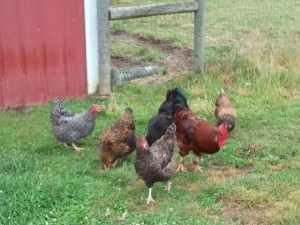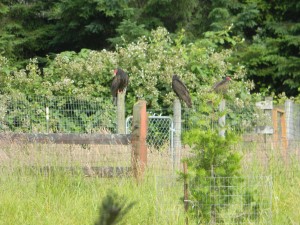Living on the land–particularly in an area that’s on the border of wilderness–is very different from living in a city. Life is much more in tune with, and to some extent controlled by, the cycles of nature, and the cycles of life and death are much more vivid and closer here.
My wife and I are now well into our third year of our new life on our small farm, which is on the edge of the Cascade Mountain range in Oregon. We are learning about the cycles of life and nature here, and are getting better each year at living in harmony with them.
We want to produce as much of our own food as we can, and each year we move farther along that path. Spring here is a time of anticipation and preparation: planning the summer garden, and starting seedlings to be planted in the garden when the weather warms. Spring also brings new lambs to our small herd. This year our two ewes gave us three lambs. We always hope for females because they are much more useful for growing the herd than males are. Last year’s two new lambs were both males–we’d hopefully named them Dierdru and Fionna, then had to change their names to Danny Boy and Finn. This year we initially held off on naming the first lamb that was born, but at about two weeks of age I happened to see it urinating–the point of origin is a sure indicator of the sex–and the first words out of my mouth–“Dammit!”–became his name. Our second ewe had twins, though, and one, at least, was a female–she now bears the name Dierdru. But our herd has grown too ram-heavy–we now have three females and five males–so we’ve taken to calling Finn “Lamb Chop” in anticipation of his future destiny. Here’s a photo of the lambs and mothers, taken in April a few weeks after they born:
 Summer is the busiest season. The garden requires much work: planting, weeding, harvesting, and preserving the harvest. The pastures, too, require our attention. The sheep help maintain them, but there is hay to be cut and stored for use in the winter. Summer, I now know, is not the season for writing. Winter will be the writing season, now that I am learning to live in harmony with the cycles here.
Summer is the busiest season. The garden requires much work: planting, weeding, harvesting, and preserving the harvest. The pastures, too, require our attention. The sheep help maintain them, but there is hay to be cut and stored for use in the winter. Summer, I now know, is not the season for writing. Winter will be the writing season, now that I am learning to live in harmony with the cycles here.
But although I am not currently actively writing, that does not mean I am not working on my books. The past few months my wife and I have focused considerable effort to make the Strongbow Saga books available in several new markets. There will be news about that coming later. And we leave in a few days for a research trip to Ireland. The Beast of Dublin, my partially finished novel which is set in Ireland in the year 840, and which tells some of Hastein’s story before the Strongbow Saga and which also will set up some characters and relationships that will figure into the final book of the Saga, is the next book I plan to complete–I hope to release it in the spring of 2015. On our research trip, we will be visiting numerous locations that figure into that story, and well as the location where the final chapters of book 5 of the Strongbow Saga will take place. That book–the final book in the Strongbow Saga–I hope to complete and publish in 2016. There is much more that goes into writing these books than just sitting down at the computer and typing.
This year, two large red-tailed hawks have nested just across the river from our farm. They frequently hunt over our farm, although a flock of crows we have befriended–we feed them regularly, and in exchange they watch over our chickens–usually drives them off when they do. I think of crows as true warrior-spirit birds. It is amazing to watch them attack much larger raptors. They are much faster and more agile than the big birds, and swirl around them, diving at their wings, until usually the hawks give up and move off to hunt somewhere that is not guarded. Once we even saw a single crow attack and harass a bald eagle that was circling over our property. The eagle did not take it kindly–at one point it rolled onto its back in flight and tried to grab the crow with its talons as it swooped by–but eventually even it gave up and flew away.
A few weeks ago, for an entire day the crows disappeared. One of our hens, a beautiful Golden Wyandotte we called Tiger, wandered away from the shelter of the barn and was caught out in the open by the two red-tailed hawks. We heard the sound and I ran up to the barn to see what had happened, but although my appearance on the scene caused the hawks to flee, I was too late. They had torn Tiger’s throat out–their preferred way to kill–although they had not yet begun to eat her.
Tiger was a big bird–our biggest hen–with a lot of meat on her. We felt it would honor and show respect for her life and death to save it, so I skinned and cut off her legs and breast. We’ll eat them, stewed as coq au vin, as our Thanksgiving dinner this year and remember her fondly when we do. The rest of her body we put out in the pasture, so nothing about her would be wasted. The turkey vultures found her, and her death gave them food. When they’d finished, nothing–not even a stray feather–was left.
Tiger’s last day:


 The cycles of life and death are much more vivid and closer here.
The cycles of life and death are much more vivid and closer here.


I’m glad you’re enjoying the cycles of life on your farm and thrilled to hear that Beat of Dublin will be finished! 🙂